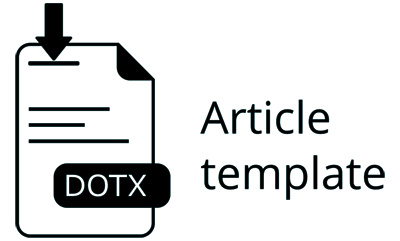KESERAGAMAN DAN PANCARAN IRIGASI PIPA PERFORASI PADA BERBAGAI KEMIRINGAN PIPA TRANSMISI
Abstract
The potential of hilly dry land needs to be developed for limited land farming to have an equal distribution of food security in various potential areas. Many existing drylands, especially in hilly and sloping areas, have not been managed optimally for agriculture due to limited support for practical irrigation techniques. Utilizing differences in existing land elevation is a potential that can be exploited by irrigation techniques that require water pressure. The perforated pipe system irrigation technique has similarities to the mini sprinkler system because it uses water pressure, and it is very possible to be applied to sloped land conditions, but the ability of the perforation system needs to be known further so that it can be used for practical irrigation. For this reason, it is necessary to test the perforated irrigation system with certain variations of the slope of the beam range and uniformity, so that later it can be used as an initial reference. The test model uses a water source from a tendon as high as 3.7 m and with a tank capacity of ± 200 liters. The diameter of the transmission pipe is ½ inch with a length of 2.55 meters, and the lateral pipe as a perforation pipe with a 3mm hole consists of 3 pipes with a pipe length of 4 meters with a diameter of 1/2 inch and the distance between the holes of the perforation pipe is 60 cm. The test was carried out on 4 variations of the slope of 10º, 20º, 30º, and 40º with 4 variations of head 1 = 2.855 m, head 2 = 2.35 m, head 3 = 1.85 m, and head 4 = 1.30 m. Based on the research results, it shows that the greater the slope of the transmission pipe, the higher the head will be. The uniformity of the perforation irrigation was getting smaller the larger the slope with a minimum value of 85% and the highest being 91%. A large perforation beam is obtained at transmission slopes of 20º and 30º, namely 2.66 m and 2.40 m.
References
Ardhigunawan, & Negara, I. D. G. J. (2010). Analisis Kinerja Sprinkler Mini terhadap Jarak Pancaran dan Estimasi Kedalaman Capaian Irigasi. Spektrum Sipil Jurnal Keilmuan Dan Aplikasi Teknik Sipil, 1(3), 163–238.
Gultom, M. A., Agustina, H., & Mursidi, R. (2012). Variasi Diameter Nosel dan Ketinggian Penyiraman Menggunakan irigasi Curah Terhadap Pemadatan Tanah. Jurnal Teknik Pertanian Sriwijaya, 1(2), 119–126.
James, L. G. (1988). Principles of Farm Irrigation System Design. New York: John Willey and Sons.
Negara, I. D. G. J., Saadi, Y., & Putra, I. B. G. (2015). Karakteristik Kinerja sprinkler Mini pada Lahan Kering Pringgabaya Utara Kabupaten Lombok Timur. Spektrum Sipil Jurnal Keilmuan Dan Aplikasi Teknik Sipil, 2(1), 28–37.
Negara, I. D. G. J., & Supriyadi, A. (2016). Analisis Rancang Bangun Sistem Irigasi Hemat Air Terpadu Berbasis Jaringan Irigasi Air Tanah (JIAT) pada Lahan Kering Tanah Bergaradasi Halus DI Pringgabaya Kabupaten Lombok Timur. Spektrum Sipil Jurnal Keilmuan Dan Aplikasi Teknik Sipil, 3(1), 49–59.
Sheikhesmaeili, O., Montero, J., & Laserna, S. (2016). Analysis of water application with semi-portable big size sprinkler irrigation systems in semi-arid areas. Agricultural Water Management, 163, 275–284. https://doi.org/10.1016/j.agwat.2015.10.004
Triatmodjo, B. (1993). Hidrolika II. Yogyakarta: Beta Offset.
Triatmodjo, B. (2003). Hidrolika II, Edisi II. Yogyakarta: Beta Offset.
Tusi, A., & Lanya, B. (2016). Rancangan Irigasi Sprinkler Portable Tanaman Pakchoy. Lampung: Universitas Lampung.
Yusuf, I. A. (2014). Kajian Kriteria Mutu Air Irigasi. Jurnal Irigasi, 9(1), 1. https://doi.org/10.31028/ji.v9.i1.1-15
Authors who publish with this journal agree to the following terms:
- Authors retain copyright and grant the journal right of first publication with the work simultaneously licensed under a Creative Commons Attribution License that allows others to share the work with an acknowledgement of the work's authorship and initial publication in this journal.
- Authors are able to enter into separate, additional contractual arrangements for the non-exclusive distribution of the journal's published version of the work (e.g., post it to an institutional repository or publish it in a book), with an acknowledgement of its initial publication in this journal.
- Authors are permitted and encouraged to post their work online (e.g., in institutional repositories or on their website) prior to and during the submission process, as it can lead to productive exchanges, as well as earlier and greater citation of published work (See The Effect of Open Access).
 Abstract viewed = 480 times
Abstract viewed = 480 times
 PDF downloaded = 1208 times
PDF downloaded = 1208 times










